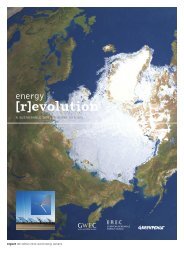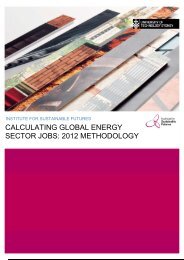download the mexico energy revolution scenario
download the mexico energy revolution scenario
download the mexico energy revolution scenario
You also want an ePaper? Increase the reach of your titles
YUMPU automatically turns print PDFs into web optimized ePapers that Google loves.
WORLD ENERGY [R]EVOLUTION<br />
A SUSTAINABLE ENERGY OUTLOOK<br />
solar <strong>the</strong>rmal collectors Solar <strong>the</strong>rmal collecting systems are<br />
based on a centuries-old principle: <strong>the</strong> sun heats up water contained<br />
in a dark vessel. Solar <strong>the</strong>rmal technologies on <strong>the</strong> market now are<br />
efficient and highly reliable, providing <strong>energy</strong> for a wide range of<br />
applications - from domestic hot water and space heating in<br />
residential and commercial buildings to swimming pool heating,<br />
solar-assisted cooling, industrial process heat and <strong>the</strong> desalination<br />
of drinking water.<br />
Although mature products exist to provide domestic hot water and<br />
space heating using solar <strong>energy</strong>, in most countries <strong>the</strong>y are not yet<br />
<strong>the</strong> norm. Integrating solar <strong>the</strong>rmal technologies into buildings at<br />
<strong>the</strong> design stage or when <strong>the</strong> heating (and cooling) system is being<br />
replaced is crucial, thus lowering <strong>the</strong> installation cost. Moreover, <strong>the</strong><br />
untapped potential in <strong>the</strong> non-residential sector will be opened up<br />
as newly developed technology becomes commercially viable.<br />
solar domestic hot water and space heating Domestic hot water<br />
production is <strong>the</strong> most common application. Depending on <strong>the</strong><br />
conditions and <strong>the</strong> system’s configuration, most of a building’s hot<br />
water requirements can be provided by solar <strong>energy</strong>. Larger systems<br />
can additionally cover a substantial part of <strong>the</strong> <strong>energy</strong> needed for<br />
space heating. There are two main types of technology:<br />
• vacuum tubes The absorber inside <strong>the</strong> vacuum tube absorbs<br />
radiation from <strong>the</strong> sun and heats up <strong>the</strong> fluid inside. Additional<br />
radiation is picked up from <strong>the</strong> reflector behind <strong>the</strong> tubes.<br />
Whatever <strong>the</strong> angle of <strong>the</strong> sun, <strong>the</strong> round shape of <strong>the</strong> vacuum<br />
tube allows it to reach <strong>the</strong> absorber. Even on a cloudy day, when<br />
<strong>the</strong> light is coming from many angles at once, <strong>the</strong> vacuum tube<br />
collector can still be effective.<br />
• flat panel This is basically a box with a glass cover which sits on<br />
<strong>the</strong> roof like a skylight. Inside is a series of copper tubes with<br />
copper fins attached. The entire structure is coated in a black<br />
substance designed to capture <strong>the</strong> sun’s rays. These rays heat up a<br />
water and antifreeze mixture which circulates from <strong>the</strong> collector<br />
down to <strong>the</strong> building’s boiler.<br />
solar assisted cooling Solar chillers use <strong>the</strong>rmal <strong>energy</strong> to produce<br />
cooling and/or dehumidify <strong>the</strong> air in a similar way to a refrigerator<br />
or conventional air-conditioning. This application is well-suited to<br />
solar <strong>the</strong>rmal <strong>energy</strong>, as <strong>the</strong> demand for cooling is often greatest<br />
when <strong>the</strong>re is most sunshine. Solar cooling has been successfully<br />
demonstrated and large-scale use can be expected in <strong>the</strong> future.<br />
figure 9.3: flat panel solar technology<br />
wind power Over <strong>the</strong> last 20 years, wind <strong>energy</strong> has become <strong>the</strong><br />
world’s fastest growing <strong>energy</strong> source. Today’s wind turbines are<br />
produced by a sophisticated mass production industry employing a<br />
technology that is efficient, cost effective and quick to install.<br />
Turbine sizes range from a few kW to over 5,000 kW, with <strong>the</strong><br />
largest turbines reaching more than 100m in height. One large wind<br />
turbine can produce enough electricity for about 5,000 households.<br />
State-of-<strong>the</strong>-art wind farms today can be as small as a few turbines<br />
and as large as several hundred MW.<br />
The global wind resource is enormous, capable of generating more<br />
electricity than <strong>the</strong> world’s total power demand, and well<br />
distributed across <strong>the</strong> five continents. Wind turbines can be<br />
operated not just in <strong>the</strong> windiest coastal areas but in countries<br />
which have no coastlines, including regions such as central Eastern<br />
Europe, central North and South America, and central Asia. The<br />
wind resource out at sea is even more productive than on land,<br />
encouraging <strong>the</strong> installation of offshore wind parks with<br />
foundations embedded in <strong>the</strong> ocean floor. In Denmark, a wind park<br />
built in 2002 uses 80 turbines to produce enough electricity for a<br />
city with a population of 150,000.<br />
Smaller wind turbines can produce power efficiently in areas that<br />
o<strong>the</strong>rwise have no access to electricity. This power can be used<br />
directly or stored in batteries. New technologies for using <strong>the</strong> wind’s<br />
power are also being developed for exposed buildings in densely<br />
populated cities.<br />
wind turbine design Significant consolidation of wind turbine<br />
design has taken place since <strong>the</strong> 1980s. The majority of commercial<br />
turbines now operate on a horizontal axis with three evenly spaced<br />
blades. These are attached to a rotor from which power is<br />
transferred through a gearbox to a generator. The gearbox and<br />
generator are contained within a housing called a nacelle. Some<br />
turbine designs avoid a gearbox by using direct drive. The electricity<br />
output is <strong>the</strong>n channelled down <strong>the</strong> tower to a transformer and<br />
eventually into <strong>the</strong> local grid network.<br />
Wind turbines can operate from a wind speed of 3-4 metres per<br />
second up to about 25 m/s. Limiting <strong>the</strong>ir power at high wind<br />
speeds is achieved ei<strong>the</strong>r by ‘stall’ regulation – reducing <strong>the</strong> power<br />
output – or ‘pitch’ control – changing <strong>the</strong> angle of <strong>the</strong> blades so<br />
that <strong>the</strong>y no longer offer any resistance to <strong>the</strong> wind. Pitch control<br />
has become <strong>the</strong> most common method. The blades can also turn at<br />
a constant or variable speed, with <strong>the</strong> latter enabling <strong>the</strong> turbine to<br />
follow more closely <strong>the</strong> changing wind speed.<br />
94



![Energy [R]evolution - European Commission](https://img.yumpu.com/49109324/1/184x260/energy-revolution-european-commission.jpg?quality=85)


![5905 gp [eu rev]csfr4.qxd - Energy [R]evolution](https://img.yumpu.com/42305023/1/184x260/5905-gp-eu-revcsfr4qxd-energy-revolution.jpg?quality=85)


![5905 gp [eu rev]csfr4.qxd - Energy [R]evolution](https://img.yumpu.com/28729264/1/184x260/5905-gp-eu-revcsfr4qxd-energy-revolution.jpg?quality=85)